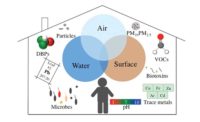The path we take in life is a mix of the random and the planned. There are conscious decisions we make that send us down a particular road. And then there are decisions that we believe to be inconsequential at the time, which turn out to be seminal.
I was reminded of this late last year, upon the passing of former ASHRAE President Bill Coad.
For me, the equivalent of a coin flip allowed me to work with one of the true thought leaders in our industry. Specifically, in 1983, because one job offer represented a shorter commute than the other, I took a job as a drafter at Charles J.R. McClure and Associates, Inc. (now known simply as McClure Engineering [www.mcclureeng.com]).
McClure was (and still is) a special place…a sort of engineering hot house where thought and innovation trumped the status quo. It was a place where engineering philosophy was discussed and imparted, and not simply alluded to in an impotent mission statement. It was a place where sustainability and energy conservation were baked in. Not because it was the popular thing, but because good mechanical design simply demanded it.
And why was McClure, McClure? Well it was due in part to one of its principals, William J. Coad.
Bill, among other things, was an engineer, an author, an entrepreneur, a professor, and a philosopher. But it’s upon that last mantle that I would like to expound — because Bill believed the difference between competence and excellence in engineering had less to do with technical knowledge and more to do with philosophy.
To put a finer point upon it, it is the approach one takes to the work that can most affect the outcome.
Kissing Einstein’s Razor
It may seem counterintuitive that the first element of exceptional engineering, arguably one of the more complicated fields of endeavor, is a charge to keep it simple. But the reality is that there is validity to the old KISS Principle (Keep It Simple Stupid).
A quote attributed to Einstein is,
Everything should be made as simple as possible, but not simpler.
Note the clarifier, “…but not simpler.” The point being that oversimplification can be as detrimental as overly complex. That’s what takes us beyond simply KISS. It’s not simplicity for simplicities sake. It’s optimization.
Further, when assessing this instruction consider that “everything” applies to the product AND the process. Yes, the design and the creation should be uncomplicated, but the approach taken should be as well.
Six hundred years before Einstein, in a similarly uncomplicated vein, William of Ockham posited the principle commonly expressed now as Occam’s Razor. The interpretation most often quoted in popular culture is, “…all things being equal, the simplest solution tends to be the best one.” But the more direct interpretation from the Latin is:
No more things should be used than are necessary.
By “things,” Ockham was referring to theories or assumptions, and their use in explaining something. But for the sake of our conversation, we can extend “things” to include the steps to a solution. Or in the case of the physical incarnation of the solution, we would state, “…no more components should be used than are necessary.”
Therefore, good engineering is a product of making fewer assumptions, avoiding unnecessary complexity in the design process, and producing designs that employ the necessities and nothing more.
As engineers, we gravitate to the more complex. Heck, if it were easy, anyone could do it, right? But good design requires us to check our ego at the door and find the simplicity in things. If we can do this — if we can reduce a design to its essentials — then we free ourselves to accomplish more.
Obsolescence or Innovation
One of the most powerful lessons Bill taught had to do with our approach to design. He said,
In design there are two resource pools available:
The laws of physics and the products of the market.
The designer of excellence works with the former,
and the designer of mediocrity works with the latter.
Broadly, we can characterize this difference as The Master versus The Matchmaker approach. Assuming both are equally capable, the difference arises from the resources they employ.
The Matchmaker, when faced with a problem, looks into the catalogue of known products and works with those products to achieve their design objective. One constraint is that the number of solutions available is directly proportional to the number of products offered. Or, to get to the solution, they may have to use more components than are necessary.
The Master, on the other hand, will consider the design objective and fully consider the physics in play. With an understanding of the psychrometrics, thermodynamics, fluid properties, etc., the problem is first quantified. Or to put it more directly, the problem is first understood.
And once a problem is understood, the solutions become obvious.
With the solutions in mind, The Master will seek out the products required to meet the challenge. And if one is needed but cannot be found in the marketplace, perhaps one can be made; this, in turn, gives birth to innovation.
Consider for a moment the need to provide neutral temperature air at a sufficiently low dew point. This is a common challenge with outdoor air systems, pool dehumidification systems, and industrial processes.
For years, The Matchmaker would use a cooling coil in series with a reheat coil. Yes, this solved the problem, but with simultaneous heating and cooling, the process was energy-intensive and required a complete cooling and heating system, i.e. chilled water and heating water.
But somewhere along the line, the Masters out there realized that you could make that same journey on the psychrometric chart by other means, including (but not limited to) run-around heat pipes, return air bypass, heat pump configurations, and total energy wheels.
In most cases, a less energy-intensive path was found. Some of them may have been technologically more complicated than the dumb-as-dirt cool and reheat sequence, but each was what it needed to be to meet its objective.
Engineering without innovation assures obsolescence. Luckily, in our free market system, there is always someone seeking a better mousetrap, and someone else smart enough to provide it. How fast that new idea makes it to market depends on many things, but the biggest obstacle is usually simply overcoming the inertia of the status quo.
But it all starts with someone asking the question and understanding the problem.
The Energy Ethic
The last “Big Idea” that I will share with you is the need to understand the role of energy conservation in the ethos of the HVAC engineer.
Energy Conservation in Engineered Systems is an Ethic.
For you youngsters out there, you may not believe it, but as little as 20 years ago, the idea that energy efficiency should be a cornerstone of architecture and MEP systems design was considered eccentric.
However, along came the new century and everyone got on board. LEED gained traction, and the private sector joined the public sector in demanding energy optimization and intelligent design.
But as engineers, we can never allow ourselves to be blinded by greenwash and sustainability mandates that are questionable at best and borderline malpractice at worst. One example being the awarding of points for additional outdoor air…even in climates like Florida…where the outcome is not only energy intensive, but can turn an HVAC system into an efficient mold spore delivery mechanism.
As HVAC engineers we have a mandate: To transfer energy as efficiently as possible. We do that by moving and heating things (technically nothing is ever cooled; it just surrenders its heat to something else…annoying First Law).
Equations Lead to Solutions
Bill would say that if you can write an equation for a problem, you have the solution. Luckily, the holy grail of HVAC equations was derived centuries ago. Specifically,
Q= (m ) Cp∆T
Where,
Q = heat transferred
(m) = mass flow rate
Cp=
specific heat of the heat transfer of the medium
∆T =
change in the medium’s temperature
This base formula gives way to our two favorite equations for air and water-cooling respectively, in IP units,
Q= CFM × 1.08 × ∆T
Q= gpm × 500 × ∆T
Let’s consider a 10,000-sq-ft data center with a nominal load of 100 W/sq ft, and in turn, a nominal load of 1 MW or about 3.4 MMbtuh. Using the formulas above and assuming the common delta-T of 20˚ for air and 12˚ for water, this data center would require about 158,000 cfm, or approximately 570 gpm to cool the facility.
Using ASHRAE 90.1-2013 Appendix – G as our baseline energy calculations1
Assuming continuous operation nominal electrical utility costs of 12 cents per kWh, the total operating cost (TOC) comparison works out to be:
So water-cooling is no brainer, right?
Not so fast. The mission critical HVAC marketplace seems to differ.
If you simply looked at the products available for computer room air conditioning and noted that the vast majority of systems available are air based (CRACs and IRCs for example) and not fluid based (at the chip, immersion, etc.), you might conclude that air systems are as good, if not better than fluid based systems. But the math doesn’t support that conclusion.
So why don’t we see more fluid cooling? See the comments earlier about market inertia. The best design solution isn’t always the one readily available. Luckily, in the data center marketplace, the big players are demanding innovation and the state of the art is evolving.
But it all starts with an ethic ... a commitment to driving the sum of that equation down as a matter of course, not as a second thought. Hey, I’m not asking you to get the First Law tattooed on your chest, just asking that you take it to heart.
Class Dismissed
So the big takeaways are:
- Keep your process and products as simple as possible.
- Innovation and excellence are dependent on your understanding the problem.
- And saving energy should be the primary driver in your endeavors.
In our day-to-day travails, many things will sway us from these ideals: schedule, budget, crazy clients, and inflexible managers. But if you always start with these tenants in mind, your path may at least be a little more enlightened.
I had the honor of working with Bill for a little more than 10 years. I left McClure in the ’90s for all the wrong reasons. But that’s the great thing about being young … you won’t know how stupid you are for another 20 years or so.
Some of us make a living and others make a difference. Bill did the latter. And even though he isn’t with us anymore, maybe my passing some of his wisdom on to others will extend that differential experience a few more decades.
I certainly hope so.
Godspeed, Mr. Coad. ES
Dickens is a Design Principal for Jacobs Global Buildings, focused on the Mission Critical and Government Sectors. He can be reached at kevin.dickens@jacobs.com.
References
1 ASHRAE 90.1-2013, Appendix G; Baseline System 11, Single Zone VAV, Chilled Water; Fan Efficiency Based on General Purpose Electric Motor (Subtype I), 100 HP, TEFC, 1800 rpm.








